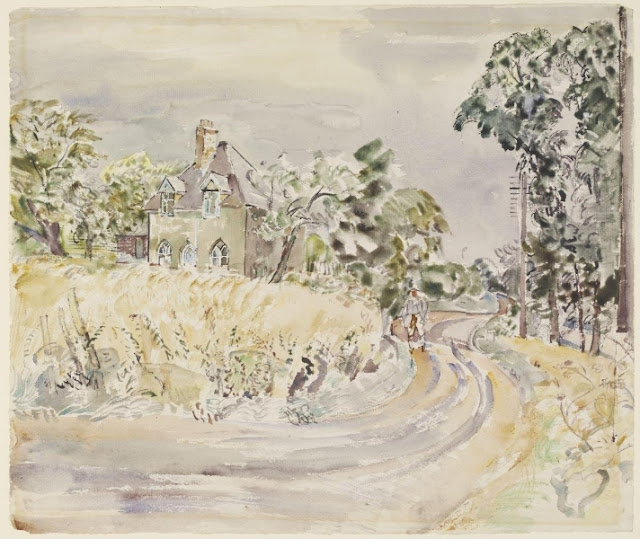Tucked away on the hill on the western Cuxton parish
boundary, just above the point where
 |
| Warren House - as it is today... |
The original building was a single storey flint cottage, with a steep thatched roof and a distinctive arched door and windows in the “Gothick” style. I am not sure exactly when it was built, but a census taken in 1841 shows that Warren House was then the residence of a Mr. Joseph Ricketts, gamekeeper. Warren House features on an 1869 Ordnance Survey map of the area (shown below) but not on an earlier (though rather crude) map of 1769, so it would be reasonable to assume that it was probably built in the early part of the 19th century.
 |
| Ordnance Survey map, revision 1869, showing Warren House... |
A photograph taken in the early part of the 20th century shows gamekeeper John Griffin and his young son, Ron, in front of the original cottage (see below).
 |
| Gamekeeper John Griffin and his son, Ron, outside Warren House, 1908... |
The OS map of 1895 (see below) showed a phesantry to the rear of the cottage, where pheasants were reared for the Darnley estate shoot.
 |
| Ordnance Survey map, 1895 revision, showing Warren House... |
Brood hens were used to hatch the pheasant eggs, hence the scene in the photograph below.
 |
| Warren House pheasantry, c 1912; L-R, Ron Griffin, John Griffin, Joe Cogger, Charlie Ashenden... |
Dormer windows were added to the cottage in 1914 (see below) to give light to bedrooms in the roof, doubtless added to make a bit more room for the Griffin’s growing family.
 |
| Warren House, c 1920... |
The Griffin family lived in the cottage until 1923, until a spark from the chimney set light to the thatched roof and the cottage burnt down. The Rochester Fire brigade attended but the cottage well had run dry and water had to be pumped from the forge down the lane. The Griffins stayed in Bush until the cottage was rebuilt, with the new cottage reconstructed much in the style of the old one, but with a tiled roof. The cottage well was back-filled in 1938, when mains water became available.
A watercolour painting (held in the Victoria and Albert Museum) shows the cottage as it appeared in 1940 (see below).
 |
| "Gamekeepers Cottage, The Warren House, Cuxton Valley", by George Hennell, c.1940... |
The cottage looked much the same in 1971 (see below)...
 |
| Warren House, 1971... |
The attractive flint walls appeared to have been rendered as part of the rebuilding work after the fire, but the "Gothick" arched windows and door were retained.
The kennels appear to have been given planning permission in 1995, and closed only recently.
By 2007, Warren House had been modernised and extended at the side and rear. Planning permission was sought in 2007 to build a 40% larger dwelling on the same plot just above the existing cottage, but was refused by Medway Council due to green belt considerations and the size of the proposed new cottage!
Obviously, Medway Council's planners are far less concerned about the green belt these days, given that they have become passionate advocates for a 16,000 m2 (!) billionaire tax exile's vanity winery at Upper Bush!
After reducing the size of their proposed new bungalow, planning permission was granted to the applicants in late 2010. However, Medway Council's (now non-existent) determination to protect the green belt led to them to specify that the old Warren House had to be demolished, so that there could not be two dwellings on the site.
 |
| Construction of the new Warren House in 2011: the original (on the right) was demolished shortly afterwards... |
Despite opposition from Cuxton Parish Council, the cottage was demolished in 2011, and so Cuxton lost another of its few remaining historic buildings.
References:
1) Cuxton: A Kentish Village by Derek Church (published by Arthur J Cassell Ltd, 1976, ISBN 0 903253 12 7), pp 76-77.
2) Ordnance Survey Maps - Six-inch England and Wales, 1842-1952
No comments:
Post a Comment